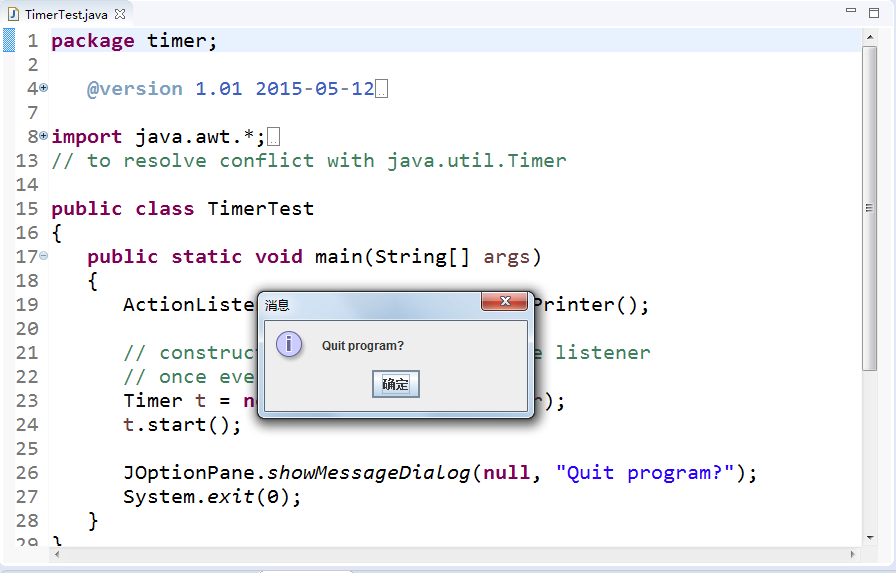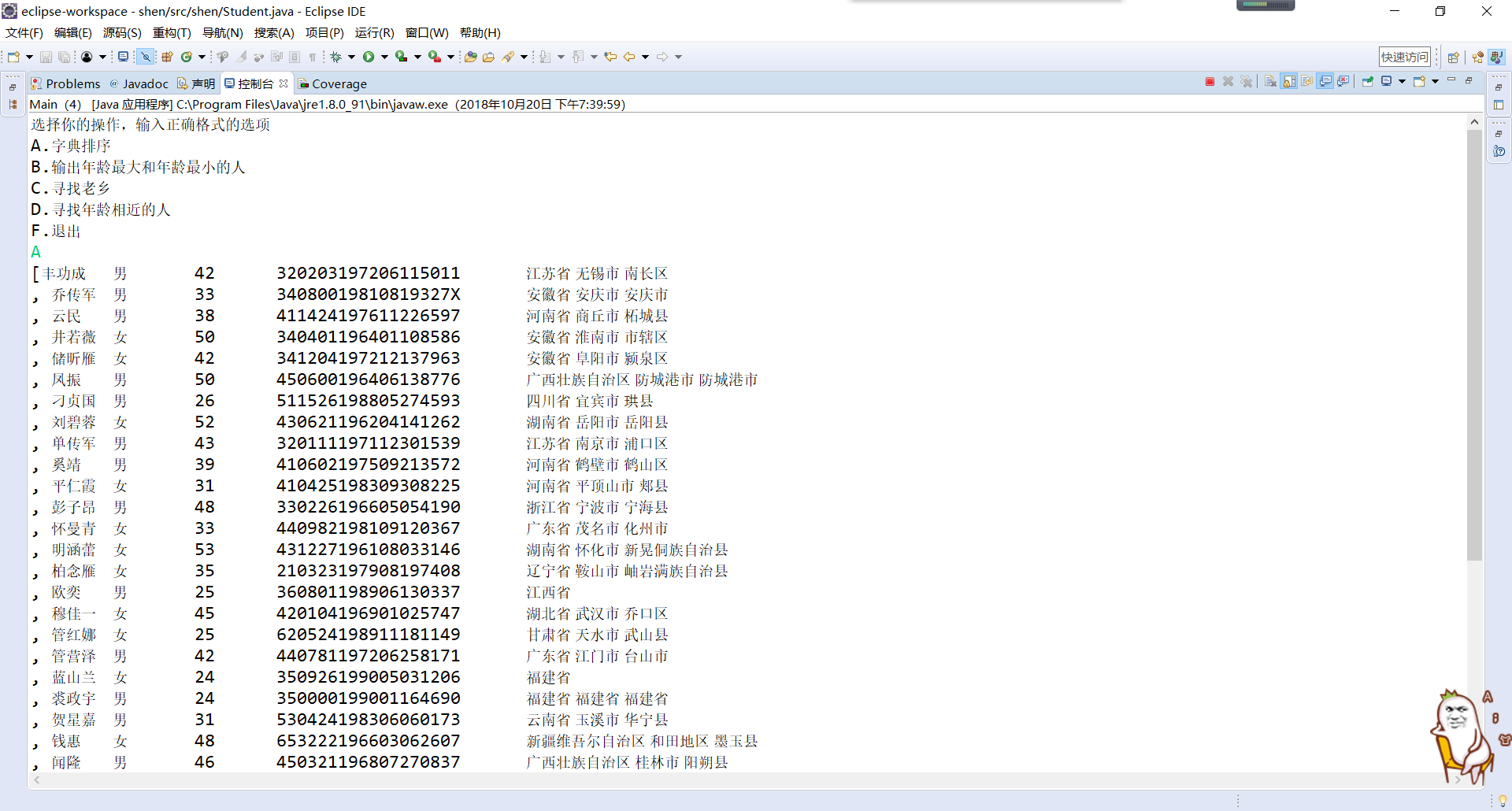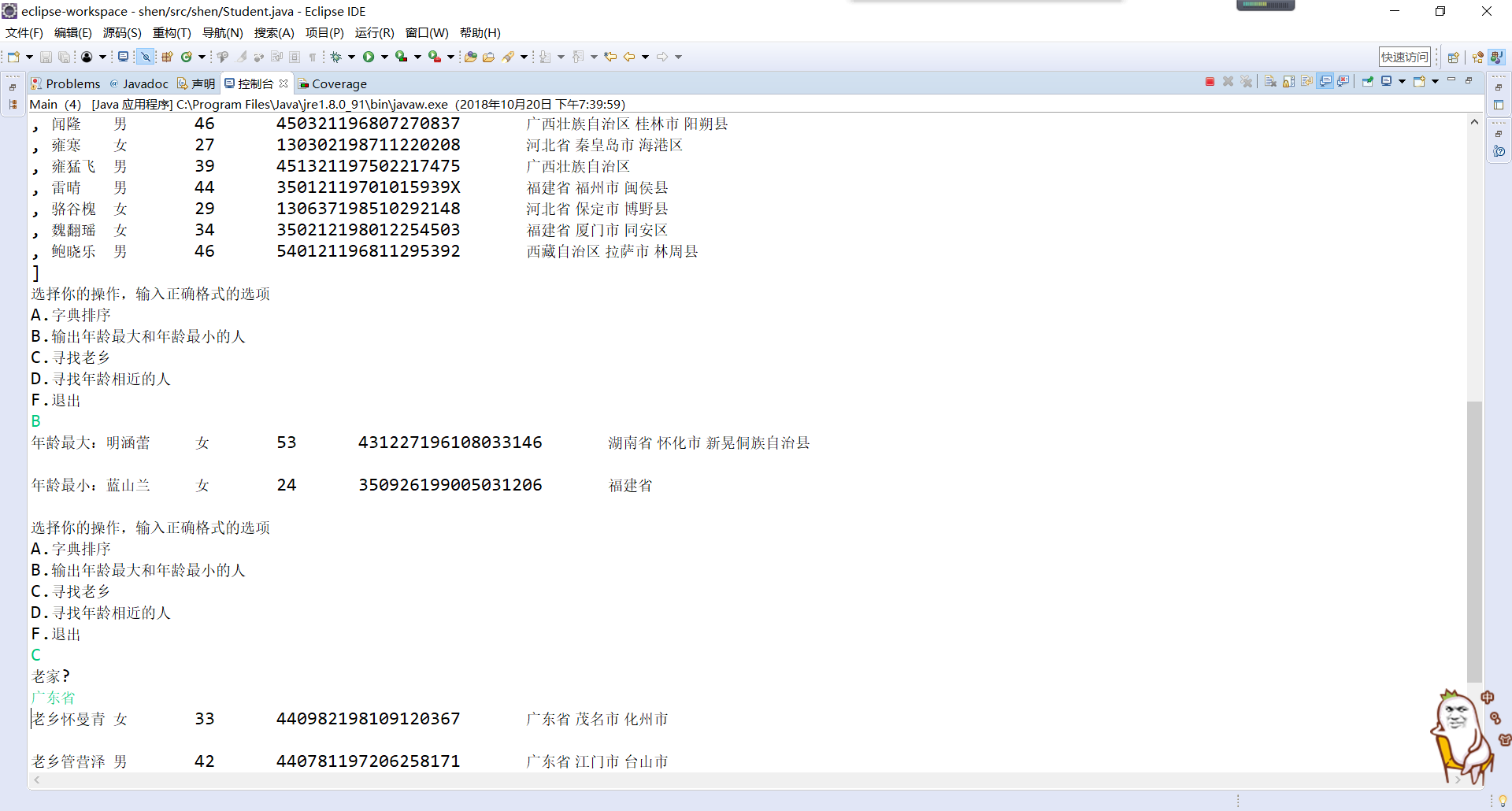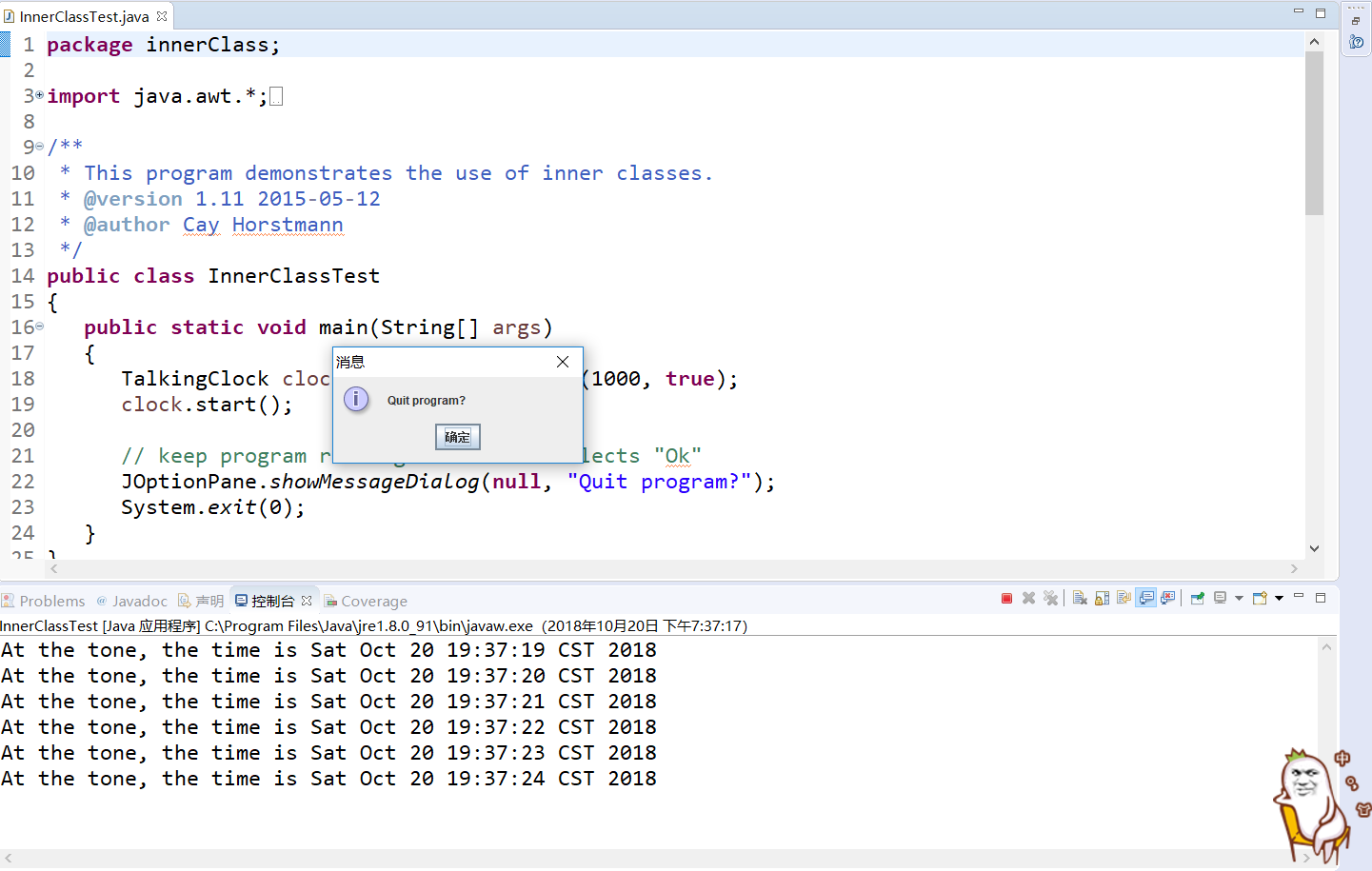王颖奇 201771010129《面向对象程序设计(java)》第八周学习总结
实验六 接口的定义与使用
实验时间 2018-10-18
1、实验目的与要求
(1) 掌握接口定义方法;
(2) 掌握实现接口类的定义要求;
(3) 掌握实现了接口类的使用要求;
(4) 掌握程序回调设计模式;
(5) 掌握Comparator接口用法;
(6) 掌握对象浅层拷贝与深层拷贝方法;
(7) 掌握Lambda表达式语法;
(8) 了解内部类的用途及语法要求。
2、实验内容和步骤
实验1: 导入第6章示例程序,测试程序并进行代码注释。
测试程序1:
l 编辑、编译、调试运行阅读教材214页-215页程序6-1、6-2,理解程序并分析程序运行结果;
l 在程序中相关代码处添加新知识的注释。
l 掌握接口的实现用法;
l 掌握内置接口Compareable的用法。
package interfaces; import java.util.*; /**
* This program demonstrates the use of the Comparable interface.
* @version 1.30 2004-02-27
* @author Cay Horstmann
*/
public class EmployeeSortTest
{
public static void main(String[] args)
{
Employee[] staff = new Employee[3]; staff[0] = new Employee("Harry Hacker", 35000);
staff[1] = new Employee("Carl Cracker", 75000);
staff[2] = new Employee("Tony Tester", 38000); Arrays.sort(staff); //输出所有关于Employee对象的信息
for (Employee e : staff)
System.out.println("name=" + e.getName() + ",salary=" + e.getSalary());
}
}
EmployeeSortTest
package interfaces; public class Employee implements Comparable<Employee>
//创建一个泛型Comparable接口,提供一个类型参数,比较Employee类的对象并进行排序
{
private String name;
private double salary; public Employee(String name, double salary)
{
this.name = name;
this.salary = salary;
} public String getName()
{
return name;
} public double getSalary()
{
return salary;
} public void raiseSalary(double byPercent)
{
double raise = salary * byPercent / 100;
salary += raise;
} /**
* Compares employees by salary
* @param other another Employee object
* @return a negative value if this employee has a lower salary than
* otherObject, 0 if the salaries are the same, a positive value otherwise
*/
public int compareTo(Employee other)
{
return Double.compare(salary, other.salary);
//salary的大小两两互相比较,升序排出salary的大小
}
}
Employee
运行结果:

测试程序2:
l 编辑、编译、调试以下程序,结合程序运行结果理解程序;
|
interface A { double g=9.8; void show( ); } class C implements A //对C使用A接口的方法 { public void show( ) { System.out.println("g="+g); } }
class InterfaceTest { public static void main(String[ ] args) { A a=new C( ); a.show( ); System.out.println("g="+C.g); } |
运行结果:


测试程序3:
l 在elipse IDE中调试运行教材223页6-3,结合程序运行结果理解程序;
l 26行、36行代码参阅224页,详细内容涉及教材12章。
l 在程序中相关代码处添加新知识的注释。
l 掌握回调程序设计模式;
package timer; /**
@version 1.01 2015-05-12
@author Cay Horstmann
*/ import java.awt.*;
import java.awt.event.*;
import java.util.*;
import javax.swing.*;
import javax.swing.Timer;
// to resolve conflict with java.util.Timer public class TimerTest
{
public static void main(String[] args)
{
ActionListener listener = new TimePrinter(); // 构造一个timer对象存放在变量里,叫做listener
// 每次间隔10秒
Timer t = new Timer(10000, listener);
t.start(); JOptionPane.showMessageDialog(null, "Quit program?");
System.exit(0);
}
} class TimePrinter implements ActionListener
{
public void actionPerformed(ActionEvent event)
{
System.out.println("At the tone, the time is " + new Date());
Toolkit.getDefaultToolkit().beep();
//每隔10秒响一次
}
}
TimerTest
运行结果:

不点“确定”,每10s,出一次结果,电脑响一次

测试程序4:
l 调试运行教材229页-231页程序6-4、6-5,结合程序运行结果理解程序;
l 在程序中相关代码处添加新知识的注释。
l 掌握对象克隆实现技术;
l 掌握浅拷贝和深拷贝的差别。
package clone; /**
* This program demonstrates cloning.
* @version 1.10 2002-07-01
* @author Cay Horstmann
*/
public class CloneTest
{
public static void main(String[] args)
{
try
//放入try中,配合后面的语句捕获异常
{
Employee original = new Employee("John Q. Public", 50000);
original.setHireDay(2000, 1, 1);
Employee copy = original.clone();
copy.raiseSalary(10);
copy.setHireDay(2002, 12, 31);
System.out.println("original=" + original);
System.out.println("copy=" + copy);
}
catch (CloneNotSupportedException e)
//捕获异常
{
e.printStackTrace();
}
}
}
CloneTest
package clone; import java.util.Date;
import java.util.GregorianCalendar; public class Employee implements Cloneable
{
private String name;
private double salary;
private Date hireDay; public Employee(String name, double salary)
{
this.name = name;
this.salary = salary;
hireDay = new Date();
} public Employee clone() throws CloneNotSupportedException
{
// call Object.clone()
Employee cloned = (Employee) super.clone(); // clone mutable fields
cloned.hireDay = (Date) hireDay.clone(); return cloned;
} /**
* Set the hire day to a given date.
* @param year the year of the hire day
* @param month the month of the hire day
* @param day the day of the hire day
*/
public void setHireDay(int year, int month, int day)
{
Date newHireDay = new GregorianCalendar(year, month - 1, day).getTime(); // Example of instance field mutation
hireDay.setTime(newHireDay.getTime());
} public void raiseSalary(double byPercent)
{
double raise = salary * byPercent / 100;
salary += raise;
} public String toString()
{
return "Employee[name=" + name + ",salary=" + salary + ",hireDay=" + hireDay + "]";
}
}
Employee
运行结果:

实验2: 导入第6章示例程序6-6,学习Lambda表达式用法。
l 调试运行教材233页-234页程序6-6,结合程序运行结果理解程序;
l 在程序中相关代码处添加新知识的注释。
l 将27-29行代码与教材223页程序对比,将27-29行代码与此程序对比,体会Lambda表达式的优点。
package lambda; import java.util.*; import javax.swing.*;
import javax.swing.Timer; /**
* This program demonstrates the use of lambda expressions.
* @version 1.0 2015-05-12
* @author Cay Horstmann
*/
public class LambdaTest
{
public static void main(String[] args)
{
String[] planets = new String[] { "Mercury", "Venus", "Earth", "Mars",
"Jupiter", "Saturn", "Uranus", "Neptune" };
System.out.println(Arrays.toString(planets));
System.out.println("Sorted in dictionary order:");
Arrays.sort(planets);
System.out.println(Arrays.toString(planets));
System.out.println("Sorted by length:");
Arrays.sort(planets, (first, second) -> first.length() - second.length());
System.out.println(Arrays.toString(planets)); Timer t = new Timer(1000, event ->
System.out.println("The time is " + new Date()));
t.start(); // keep program running until user selects "Ok"
JOptionPane.showMessageDialog(null, "Quit program?");
System.exit(0);
}
}
LambdaTest
运行结果:


注:以下实验课后完成
实验3: 编程练习
l 编制一个程序,将身份证号.txt 中的信息读入到内存中;
l 按姓名字典序输出人员信息;
l 查询最大年龄的人员信息;
l 查询最小年龄人员信息;
l 输入你的年龄,查询身份证号.txt中年龄与你最近人的姓名、身份证号、年龄、性别和出生地;
查询人员中是否有你的同乡。
package shen; import java.io.BufferedReader;
import java.io.File;
import java.io.FileInputStream;
import java.io.FileNotFoundException;
import java.io.IOException;
import java.io.InputStreamReader;
import java.util.ArrayList;
import java.util.Arrays;
import java.util.Collections;
import java.util.Scanner; public class Main{
private static ArrayList<Student> studentlist;
public static void main(String[] args) {
studentlist = new ArrayList<>();
Scanner scanner = new Scanner(System.in);
File file = new File("C:\\Users\\ASUS\\Desktop\\新建文件夹\\身份证号.txt");
try {
FileInputStream fis = new FileInputStream(file);
BufferedReader in = new BufferedReader(new InputStreamReader(fis));
String temp = null;
while ((temp = in.readLine()) != null) { Scanner linescanner = new Scanner(temp); linescanner.useDelimiter(" ");
String name = linescanner.next();
String number = linescanner.next();
String sex = linescanner.next();
String age = linescanner.next();
String province =linescanner.nextLine();
Student student = new Student();
student.setName(name);
student.setnumber(number);
student.setsex(sex);
int a = Integer.parseInt(age);
student.setage(a);
student.setprovince(province);
studentlist.add(student); }
} catch (FileNotFoundException e) {
System.out.println("学生信息文件找不到");
e.printStackTrace();
} catch (IOException e) {
System.out.println("学生信息文件读取错误");
e.printStackTrace();
}
boolean isTrue = true;
while (isTrue) {
System.out.println("选择你的操作,输入正确格式的选项");
System.out.println("A.字典排序");
System.out.println("B.输出年龄最大和年龄最小的人");
System.out.println("C.寻找老乡");
System.out.println("D.寻找年龄相近的人");
System.out.println("F.退出");
String m = scanner.next();
switch (m) {
case "A":
Collections.sort(studentlist);
System.out.println(studentlist.toString());
break;
case "B":
int max=0,min=100;
int j,k1 = 0,k2=0;
for(int i=1;i<studentlist.size();i++)
{
j=studentlist.get(i).getage();
if(j>max)
{
max=j;
k1=i;
}
if(j<min)
{
min=j;
k2=i;
} }
System.out.println("年龄最大:"+studentlist.get(k1));
System.out.println("年龄最小:"+studentlist.get(k2));
break;
case "C":
System.out.println("老家?");
String find = scanner.next();
String place=find.substring(0,3);
for (int i = 0; i <studentlist.size(); i++)
{
if(studentlist.get(i).getprovince().substring(1,4).equals(place))
System.out.println("老乡"+studentlist.get(i));
}
break; case "D":
System.out.println("年龄:");
int yourage = scanner.nextInt();
int near=agenear(yourage);
int value=yourage-studentlist.get(near).getage();
System.out.println(""+studentlist.get(near));
break;
case "F":
isTrue = false;
System.out.println("退出程序!");
break;
default:
System.out.println("输入有误"); }
}
}
public static int agenear(int age) {
int j=0,min=53,value=0,k=0;
for (int i = 0; i < studentlist.size(); i++)
{
value=studentlist.get(i).getage()-age;
if(value<0) value=-value;
if (value<min)
{
min=value;
k=i;
}
}
return k;
} }
Main
package shen;
public class Student implements Comparable<Student> {
private String name;
private String number ;
private String sex ;
private int age;
private String province;
public String getName() {
return name;
}
public void setName(String name) {
this.name = name;
}
public String getnumber() {
return number;
}
public void setnumber(String number) {
this.number = number;
}
public String getsex() {
return sex ;
}
public void setsex(String sex ) {
this.sex =sex ;
}
public int getage() {
return age;
}
public void setage(int age) {
// int a = Integer.parseInt(age);
this.age= age;
}
public String getprovince() {
return province;
}
public void setprovince(String province) {
this.province=province ;
}
public int compareTo(Student o) {
return this.name.compareTo(o.getName());
}
public String toString() {
return name+"\t"+sex+"\t"+age+"\t"+number+"\t"+province+"\n";
}
}
Student
运行结果:



实验4:内部类语法验证实验
实验程序1:
l 编辑、调试运行教材246页-247页程序6-7,结合程序运行结果理解程序;
l 了解内部类的基本用法。
package innerClass; import java.awt.*;
import java.awt.event.*;
import java.util.*;
import javax.swing.*;
import javax.swing.Timer; /**
* This program demonstrates the use of inner classes.
* @version 1.11 2015-05-12
* @author Cay Horstmann
*/
public class InnerClassTest
{
public static void main(String[] args)
{
TalkingClock clock = new TalkingClock(1000, true);
clock.start(); // keep program running until user selects "Ok"
JOptionPane.showMessageDialog(null, "Quit program?");
System.exit(0);
}
} /**
* A clock that prints the time in regular intervals.
*/
class TalkingClock
{
private int interval;
private boolean beep; /**
* Constructs a talking clock
* @param interval the interval between messages (in milliseconds)
* @param beep true if the clock should beep
*/
public TalkingClock(int interval, boolean beep)
{
this.interval = interval;
this.beep = beep;
} /**
* Starts the clock.
*/
public void start()
{
ActionListener listener = new TimePrinter();
Timer t = new Timer(interval, listener);
t.start();
} public class TimePrinter implements ActionListener
{
public void actionPerformed(ActionEvent event)
{
System.out.println("At the tone, the time is " + new Date());
if (beep) Toolkit.getDefaultToolkit().beep();
}
}
}
InnerClassTest

实验程序2:
l 编辑、调试运行教材254页程序6-8,结合程序运行结果理解程序;
l 了解匿名内部类的用法。
package anonymousInnerClass; import java.awt.*;
import java.awt.event.*;
import java.util.*;
import javax.swing.*;
import javax.swing.Timer; /**
* This program demonstrates anonymous inner classes.
* @version 1.11 2015-05-12
* @author Cay Horstmann
*/
public class AnonymousInnerClassTest
{
public static void main(String[] args)
{
TalkingClock clock = new TalkingClock();
clock.start(1000, true); // keep program running until user selects "Ok"
JOptionPane.showMessageDialog(null, "Quit program?");
System.exit(0);
}
} /**
* A clock that prints the time in regular intervals.
*/
class TalkingClock
{
/**
* Starts the clock.
* @param interval the interval between messages (in milliseconds)
* @param beep true if the clock should beep
*/
public void start(int interval, boolean beep)
{
ActionListener listener = new ActionListener()
{
public void actionPerformed(ActionEvent event)
{
System.out.println("At the tone, the time is " + new Date());
if (beep) Toolkit.getDefaultToolkit().beep();
}
};
Timer t = new Timer(interval, listener);
t.start();
}
}
anonymousInnerClass
运行结果:

实验程序3:
l 在elipse IDE中调试运行教材257页-258页程序6-9,结合程序运行结果理解程序;
l 了解静态内部类的用法。
package staticInnerClass; /**
* This program demonstrates the use of static inner classes.
* @version 1.02 2015-05-12
* @author Cay Horstmann
*/
public class StaticInnerClassTest
{
public static void main(String[] args)
{
double[] d = new double[20];
for (int i = 0; i < d.length; i++)
d[i] = 100 * Math.random();
ArrayAlg.Pair p = ArrayAlg.minmax(d);
System.out.println("min = " + p.getFirst());
System.out.println("max = " + p.getSecond());
}
} class ArrayAlg
{
/**
* A pair of floating-point numbers
*/
public static class Pair
{
private double first;
private double second; /**
* Constructs a pair from two floating-point numbers
* @param f the first number
* @param s the second number
*/
public Pair(double f, double s)
{
first = f;
second = s;
} /**
* Returns the first number of the pair
* @return the first number
*/
public double getFirst()
{
return first;
} /**
* Returns the second number of the pair
* @return the second number
*/
public double getSecond()
{
return second;
}
} /**
* Computes both the minimum and the maximum of an array
* @param values an array of floating-point numbers
* @return a pair whose first element is the minimum and whose second element
* is the maximum
*/
public static Pair minmax(double[] values)
{
double min = Double.POSITIVE_INFINITY;
double max = Double.NEGATIVE_INFINITY;
for (double v : values)
{
if (min > v) min = v;
if (max < v) max = v;
}
return new Pair(min, max);
}
}
StaticInnerClassTest
运行结果:

学习总结:
接口的概念:
①java为了克服单继承的缺点而引入接口。
②接口不是类,而是对类的一组需求描述,这类要遵从从接口描述的统一格式进行定义。
③一个类可以实现(implement)一个或多个接口,并在需要接口的地方,随时实现相应的接口对象。
声明:接口体中包含常量定义和方法定义,接口中只进行方法的声明,不提供方法的实现。
说明:
1)通常接口的名字以able或ible结尾;
2)可以使用extends来继承接口的常量和抽象方法,扩展形成新的接口;
3)接口中的所有常量必须是public static final,方法必须是public abstract,这是系统默认的,不管你在定义接口时,写不写修饰符都是一样的。
接口的实现:在类声明时使用implement关键字实现一个或多个接口(用逗号隔开),且一个类若使用了某个接口,那么这个类必须实现该个接口的所有方法,即提供方法体。
说明:
(1)若实现接口的类不是抽象类,则必须实现所有接口的所有方法,即为所有的抽象方法定义方法体。
(2)一个类在实现某接口抽象方法时,必须使用完全相同的方法名、参数列表和返回值类型。
(3)接口抽象方法的访问控制符已指定为public,所以类在实现时,必须显式地使用public修饰符,否则被警告缩小了接口中定义的方法的访问控制范围。
接口的使用:
接口不能构造接口对象,但可以声明接口变量以指向一个实现了该接口的类对象。
接口与抽象类:
接口与抽象类的区别:
(1)接口不能实现任何方法,而抽象类可以。
(2)类可以实现许多接口,但只有一个父类。
(3)接口不是类分级结构的一部分,无任何联系的类可以实现相同的接口。
掌握CompareTo接口和Comparator接口使用方法
回调的定义与用法
对象克隆:
*Object类的Clone方法
*浅层拷贝与深层拷贝
浅层拷贝:被拷贝对象的所有常量成员和基本类型属性都有与原来对象相同的拷贝值,而若成员域是一个对象,则被拷贝对象该对象域的对象引用仍然指向原来的对象。
深层拷贝:被拷贝对象的所有成员域都含有与原来对象相同的值,且对象域将指向被复制过的新对象,而不是原有对象被引用的对象。换言之,深层拷贝将拷贝对象内引用的对象也拷贝一遍。
*Java中对象克隆的实现
Lambda表达式:
这是一种表示可以在将来某个时间点执行代码块的简洁方法。
感受:
通过一个周的学习,我大致掌握了接口的概念和实现方法,能够使用接口编写一些简单程序,并会使用comparable接口里的CompareTo和Comparator方法;初步的了解了克隆的概念,但是仍有一些小问题(深层拷贝和浅层拷贝的地方),仍需要学习和老师的讲解;lambda表达式可以简化程序的编写。
王颖奇 201771010129《面向对象程序设计(java)》第八周学习总结的更多相关文章
- 201771010134杨其菊《面向对象程序设计java》第九周学习总结
第九周学习总结 第一部分:理论知识 异常.断言和调试.日志 1.捕获 ...
- 201871010132-张潇潇《面向对象程序设计(java)》第一周学习总结
面向对象程序设计(Java) 博文正文开头 项目 内容 这个作业属于哪个课程 https://www.cnblogs.com/nwnu-daizh/ 这个作业的要求在哪里 https://www.cn ...
- 扎西平措 201571030332《面向对象程序设计 Java 》第一周学习总结
<面向对象程序设计(java)>第一周学习总结 正文开头: 项目 内容 这个作业属于哪个课程 https://www.cnblogs.com/nwnu-daizh/ 这个作业的要求在哪里 ...
- 杨其菊201771010134《面向对象程序设计Java》第二周学习总结
第三章 Java基本程序设计结构 第一部分:(理论知识部分) 本章主要学习:基本内容:数据类型:变量:运算符:类型转换,字符串,输入输出,控制流程,大数值以及数组. 1.基本概念: 1)标识符:由字母 ...
- 201871010124 王生涛《面向对象程序设计JAVA》第一周学习总结
项目 内容 这个作业属于哪个课程 https://www.cnblogs.com/nwnu-daizh/ 这个作业的要求在哪里 https://edu.cnblogs.com/campus/xbsf/ ...
- 201871010115——马北《面向对象程序设计JAVA》第二周学习总结
项目 内容 这个作业属于哪个课程 https://www.cnblogs.com/nwnu-daizh/ 这个作业的要求在哪里 https://www.cnblogs.com/nwnu-daizh/p ...
- 201777010217-金云馨《面向对象程序设计(Java)》第二周学习总结
项目 内容 这个作业属于哪个课程 https://www.cnblogs.com/nwnu-daizh/ 这个作业的要求在哪里 https://www.cnblogs.com/nwnu-daizh/p ...
- 201871010132——张潇潇《面向对象程序设计JAVA》第二周学习总结
项目 内容 这个作业属于哪个课程 https://www.cnblogs.com/nwnu-daizh/ 这个作业的要求在哪里 https://www.cnblogs.com/nwnu-daizh/p ...
- 201771010123汪慧和《面向对象程序设计Java》第二周学习总结
一.理论知识部分 1.标识符由字母.下划线.美元符号和数字组成, 且第一个符号不能为数字.标识符可用作: 类名.变量名.方法名.数组名.文件名等.第二部分:理论知识学习部分 2.关键字就是Java语言 ...
- 20155321 2016-2017-2 《Java程序设计》第八周学习总结
20155321 2016-2017-2 <Java程序设计>第八周学习总结 教材学习内容总结 创建Logger对象 static Logger getLogger(String name ...
随机推荐
- API联调神器PostMan使用详解
简介 创建 + 测试:创建和发送任何的HTTP请求,请求可以保存到历史中再次执行 Organize:使用Postman Collections为更有效的测试及集成工作流管理和组织APIs docume ...
- 6. 浅谈super
this和super: super( ) EX6类的继承, 在react中官方固定应用 在java面向对象思想中这样定义: this表示当前对象,this()为当前对象的其他构造函数 super表示父 ...
- Linux常见提权
常见的linux提权 内核漏洞提权 查看发行版 cat /etc/issue cat /etc/*-release 查看内核版本 uname -a 查看已经安装的程序 dpkg -l rpm -qa ...
- NGINX 类漏洞 整理记录
简单介绍NGINX: Nginx是一款轻量级的Web 服务器/反向代理服务器及电子邮件(IMAP/POP3)代理服务器,在BSD-like 协议下发行. 其特点是占有内存少,并发能力强,nginx的并 ...
- Springboot:JSR303数据校验(五)
@Validated //开启JSR303数据校验注解 校验规则如下: [一]空检查 @Null 验证对象是否为null @NotNull 验证对象是否不为null, 无法查检长度为0的字符串 @No ...
- select和epoll区别
select.epoll 区别总结: 1.支持一个进程所能打开的最大连接数 select 单个进程所能打开的最大连接数有FD_SETSIZE宏定义,其大小是32个整数的大小(在32位的机器上,大小就是 ...
- [Inno Setup] 卸载 重启之后 删除文件
某些系统文件,例如驱动,不重启无法删除. 利用windows注册表里的 RunOnce.注意必须在HKLM下,否则可能权限不够. 不能直接填cmd命令,要以cmd的参数形式填写. procedure ...
- SQL之常用函数
表8-2 中的SOUNDEX 需要做进一步的解释.SOUNDEX 是一个将任何文本串转换为描述其语音表示的字母数字模式的算法.SOUNDEX 考虑了类似的发音字符和音节,使得能对字符串进行发音比较而不 ...
- 【Linux题目】第六关
[定时任务规则] 1. 如果在某用户的crontab文件中有以下记录,该行中的命令多久执行一次(RHCE考试题)?( ) 30 4 * * 3 mycmd A. 每小时. B. 每周. C. 每年三月 ...
- 标准库shelve
shelve模块是一个简单的k,v将内存数据通过文件持久化的模块,可以持久化任何pickle可支持的python数据格式. 1 2 3 4 5 6 7 8 9 10 11 12 13 14 15 16 ...
